sensor LINCOLN MKS 2016 User Guide
[x] Cancel search | Manufacturer: LINCOLN, Model Year: 2016, Model line: MKS, Model: LINCOLN MKS 2016Pages: 382, PDF Size: 3.81 MB
Page 47 of 382
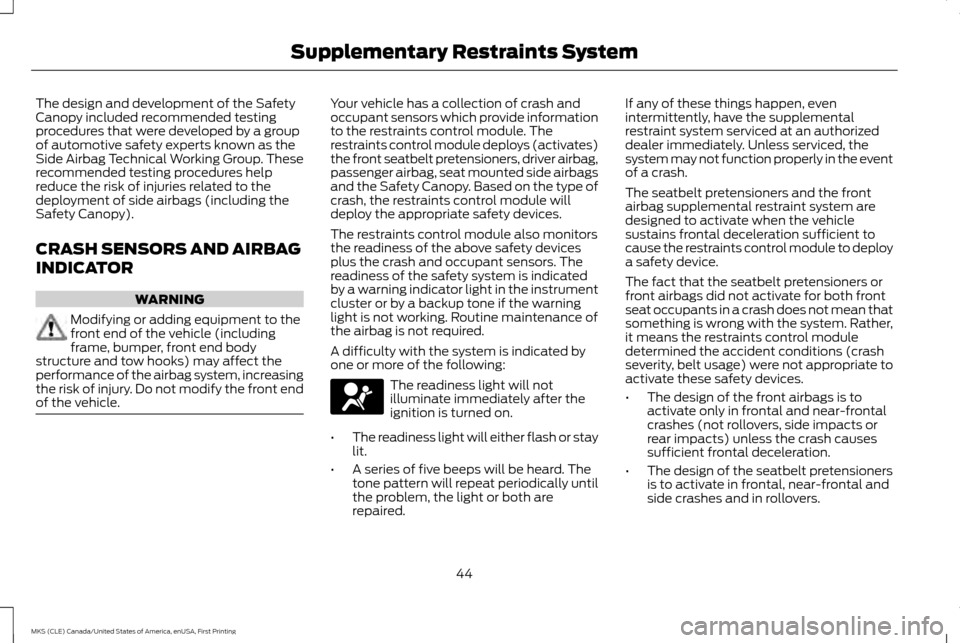
The design and development of the Safety
Canopy included recommended testing
procedures that were developed by a group
of automotive safety experts known as the
Side Airbag Technical Working Group. These
recommended testing procedures help
reduce the risk of injuries related to the
deployment of side airbags (including the
Safety Canopy).
CRASH SENSORS AND AIRBAG
INDICATOR
WARNING
Modifying or adding equipment to the
front end of the vehicle (including
frame, bumper, front end body
structure and tow hooks) may affect the
performance of the airbag system, increasing
the risk of injury. Do not modify the front end
of the vehicle. Your vehicle has a collection of crash and
occupant sensors which provide information
to the restraints control module. The
restraints control module deploys (activates)
the front seatbelt pretensioners, driver airbag,
passenger airbag, seat mounted side airbags
and the Safety Canopy. Based on the type of
crash, the restraints control module will
deploy the appropriate safety devices.
The restraints control module also monitors
the readiness of the above safety devices
plus the crash and occupant sensors. The
readiness of the safety system is indicated
by a warning indicator light in the instrument
cluster or by a backup tone if the warning
light is not working. Routine maintenance of
the airbag is not required.
A difficulty with the system is indicated by
one or more of the following:
The readiness light will not
illuminate immediately after the
ignition is turned on.
• The readiness light will either flash or stay
lit.
• A series of five beeps will be heard. The
tone pattern will repeat periodically until
the problem, the light or both are
repaired. If any of these things happen, even
intermittently, have the supplemental
restraint system serviced at an authorized
dealer immediately. Unless serviced, the
system may not function properly in the event
of a crash.
The seatbelt pretensioners and the front
airbag supplemental restraint system are
designed to activate when the vehicle
sustains frontal deceleration sufficient to
cause the restraints control module to deploy
a safety device.
The fact that the seatbelt pretensioners or
front airbags did not activate for both front
seat occupants in a crash does not mean that
something is wrong with the system. Rather,
it means the restraints control module
determined the accident conditions (crash
severity, belt usage) were not appropriate to
activate these safety devices.
•
The design of the front airbags is to
activate only in frontal and near-frontal
crashes (not rollovers, side impacts or
rear impacts) unless the crash causes
sufficient frontal deceleration.
• The design of the seatbelt pretensioners
is to activate in frontal, near-frontal and
side crashes and in rollovers.
44
MKS (CLE) Canada/United States of America, enUSA, First Printing Supplementary Restraints System
Page 60 of 382
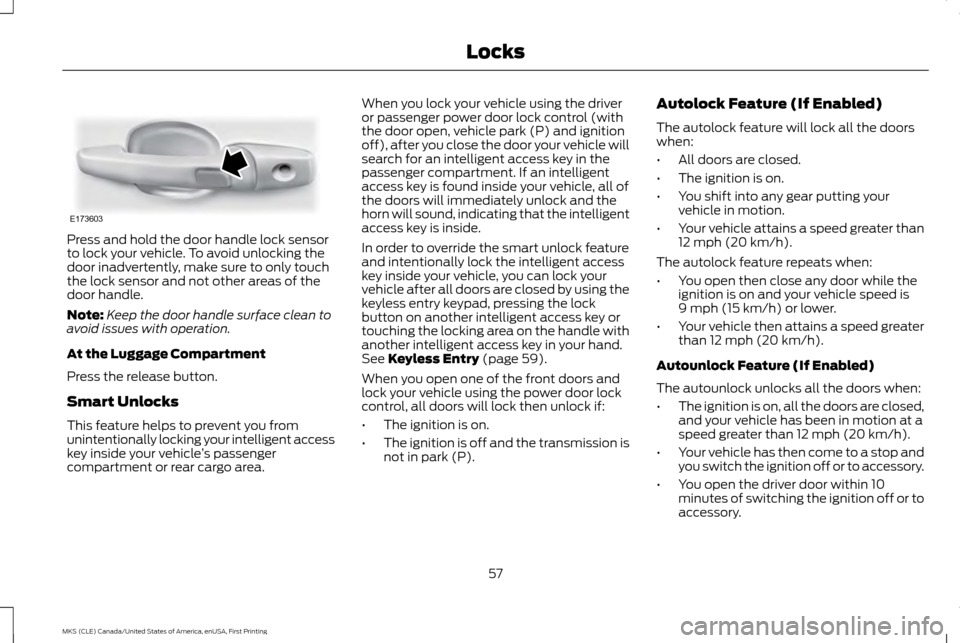
Press and hold the door handle lock sensor
to lock your vehicle. To avoid unlocking the
door inadvertently, make sure to only touch
the lock sensor and not other areas of the
door handle.
Note:
Keep the door handle surface clean to
avoid issues with operation.
At the Luggage Compartment
Press the release button.
Smart Unlocks
This feature helps to prevent you from
unintentionally locking your intelligent access
key inside your vehicle ’s passenger
compartment or rear cargo area. When you lock your vehicle using the driver
or passenger power door lock control (with
the door open, vehicle park (P) and ignition
off), after you close the door your vehicle will
search for an intelligent access key in the
passenger compartment. If an intelligent
access key is found inside your vehicle, all of
the doors will immediately unlock and the
horn will sound, indicating that the intelligent
access key is inside.
In order to override the smart unlock feature
and intentionally lock the intelligent access
key inside your vehicle, you can lock your
vehicle after all doors are closed by using the
keyless entry keypad, pressing the lock
button on another intelligent access key or
touching the locking area on the handle with
another intelligent access key in your hand.
See Keyless Entry (page 59).
When you open one of the front doors and
lock your vehicle using the power door lock
control, all doors will lock then unlock if:
• The ignition is on.
• The ignition is off and the transmission is
not in park (P). Autolock Feature (If Enabled)
The autolock feature will lock all the doors
when:
•
All doors are closed.
• The ignition is on.
• You shift into any gear putting your
vehicle in motion.
• Your vehicle attains a speed greater than
12 mph (20 km/h)
.
The autolock feature repeats when:
• You open then close any door while the
ignition is on and your vehicle speed is
9 mph (15 km/h)
or lower.
• Your vehicle then attains a speed greater
than
12 mph (20 km/h).
Autounlock Feature (If Enabled)
The autounlock unlocks all the doors when:
• The ignition is on, all the doors are closed,
and your vehicle has been in motion at a
speed greater than
12 mph (20 km/h).
• Your vehicle has then come to a stop and
you switch the ignition off or to accessory.
• You open the driver door within 10
minutes of switching the ignition off or to
accessory.
57
MKS (CLE) Canada/United States of America, enUSA, First Printing LocksE173603
Page 72 of 382
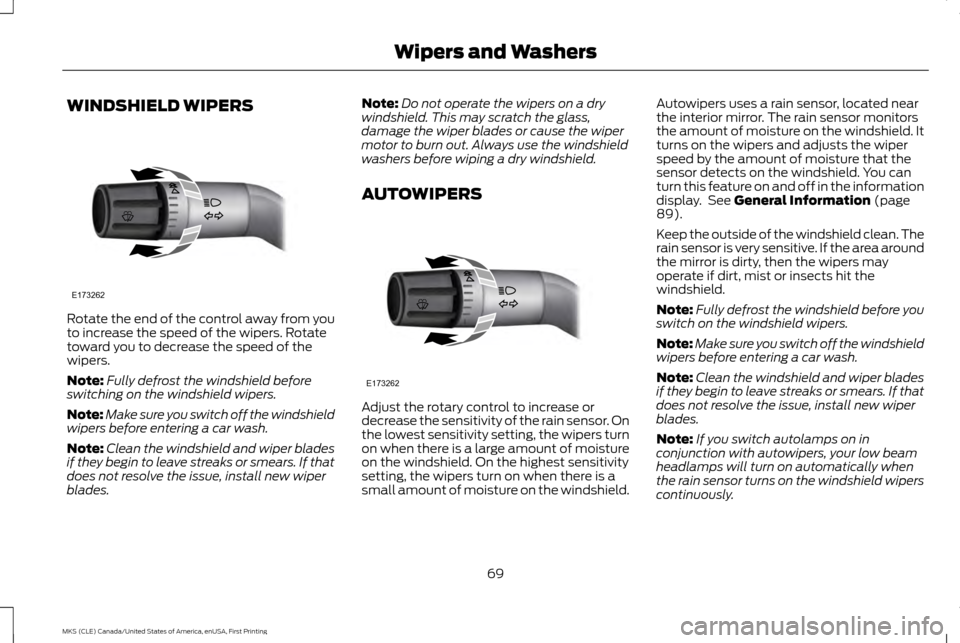
WINDSHIELD WIPERS
Rotate the end of the control away from you
to increase the speed of the wipers. Rotate
toward you to decrease the speed of the
wipers.
Note:
Fully defrost the windshield before
switching on the windshield wipers.
Note: Make sure you switch off the windshield
wipers before entering a car wash.
Note: Clean the windshield and wiper blades
if they begin to leave streaks or smears. If that
does not resolve the issue, install new wiper
blades. Note:
Do not operate the wipers on a dry
windshield. This may scratch the glass,
damage the wiper blades or cause the wiper
motor to burn out. Always use the windshield
washers before wiping a dry windshield.
AUTOWIPERS Adjust the rotary control to increase or
decrease the sensitivity of the rain sensor. On
the lowest sensitivity setting, the wipers turn
on when there is a large amount of moisture
on the windshield. On the highest sensitivity
setting, the wipers turn on when there is a
small amount of moisture on the windshield.Autowipers uses a rain sensor, located near
the interior mirror. The rain sensor monitors
the amount of moisture on the windshield. It
turns on the wipers and adjusts the wiper
speed by the amount of moisture that the
sensor detects on the windshield. You can
turn this feature on and off in the information
display. See General Information (page
89).
Keep the outside of the windshield clean. The
rain sensor is very sensitive. If the area around
the mirror is dirty, then the wipers may
operate if dirt, mist or insects hit the
windshield.
Note: Fully defrost the windshield before you
switch on the windshield wipers.
Note: Make sure you switch off the windshield
wipers before entering a car wash.
Note: Clean the windshield and wiper blades
if they begin to leave streaks or smears. If that
does not resolve the issue, install new wiper
blades.
Note: If you switch autolamps on in
conjunction with autowipers, your low beam
headlamps will turn on automatically when
the rain sensor turns on the windshield wipers
continuously.
69
MKS (CLE) Canada/United States of America, enUSA, First Printing Wipers and WashersE173262 E173262
Page 77 of 382
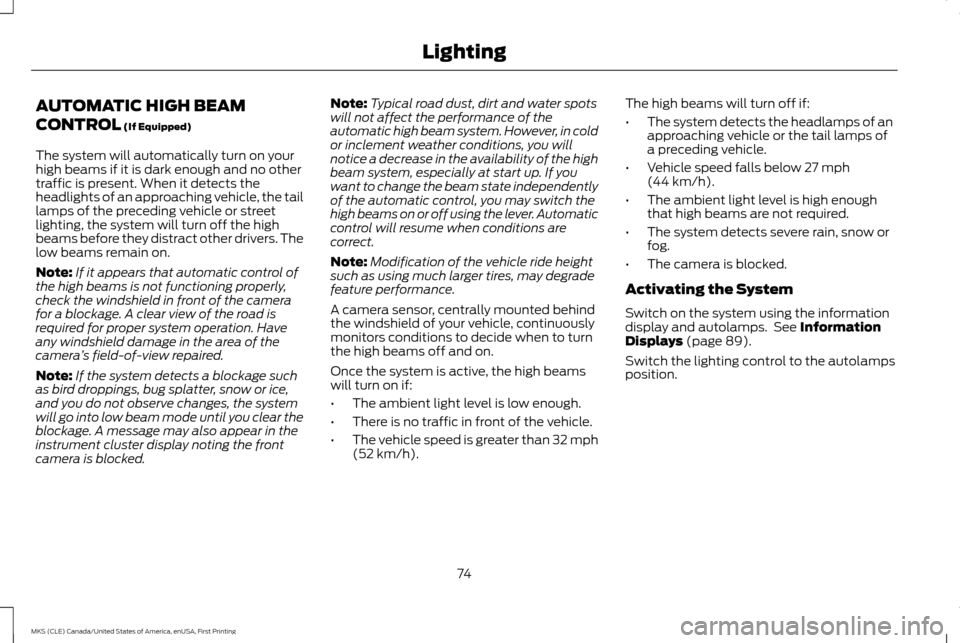
AUTOMATIC HIGH BEAM
CONTROL (If Equipped)
The system will automatically turn on your
high beams if it is dark enough and no other
traffic is present. When it detects the
headlights of an approaching vehicle, the tail
lamps of the preceding vehicle or street
lighting, the system will turn off the high
beams before they distract other drivers. The
low beams remain on.
Note: If it appears that automatic control of
the high beams is not functioning properly,
check the windshield in front of the camera
for a blockage. A clear view of the road is
required for proper system operation. Have
any windshield damage in the area of the
camera ’s field-of-view repaired.
Note: If the system detects a blockage such
as bird droppings, bug splatter, snow or ice,
and you do not observe changes, the system
will go into low beam mode until you clear the
blockage. A message may also appear in the
instrument cluster display noting the front
camera is blocked. Note:
Typical road dust, dirt and water spots
will not affect the performance of the
automatic high beam system. However, in cold
or inclement weather conditions, you will
notice a decrease in the availability of the high
beam system, especially at start up. If you
want to change the beam state independently
of the automatic control, you may switch the
high beams on or off using the lever. Automatic
control will resume when conditions are
correct.
Note: Modification of the vehicle ride height
such as using much larger tires, may degrade
feature performance.
A camera sensor, centrally mounted behind
the windshield of your vehicle, continuously
monitors conditions to decide when to turn
the high beams off and on.
Once the system is active, the high beams
will turn on if:
• The ambient light level is low enough.
• There is no traffic in front of the vehicle.
• The vehicle speed is greater than 32 mph
(52 km/h). T
he high beams will turn off if:
• The system detects the headlamps of an
approaching vehicle or the tail lamps of
a preceding vehicle.
• Vehicle speed falls below 27 mph
(44 km/h)
.
• The ambient light level is high enough
that high beams are not required.
• The system detects severe rain, snow or
fog.
• The camera is blocked.
Activating the System
Switch on the system using the information
display and autolamps. See Information
Displays (page 89
). Switch the lighting control to the autolamps
position.
74
MKS (CLE) Canada/United States of America, enUSA, First Printing Lighting
Page 84 of 382
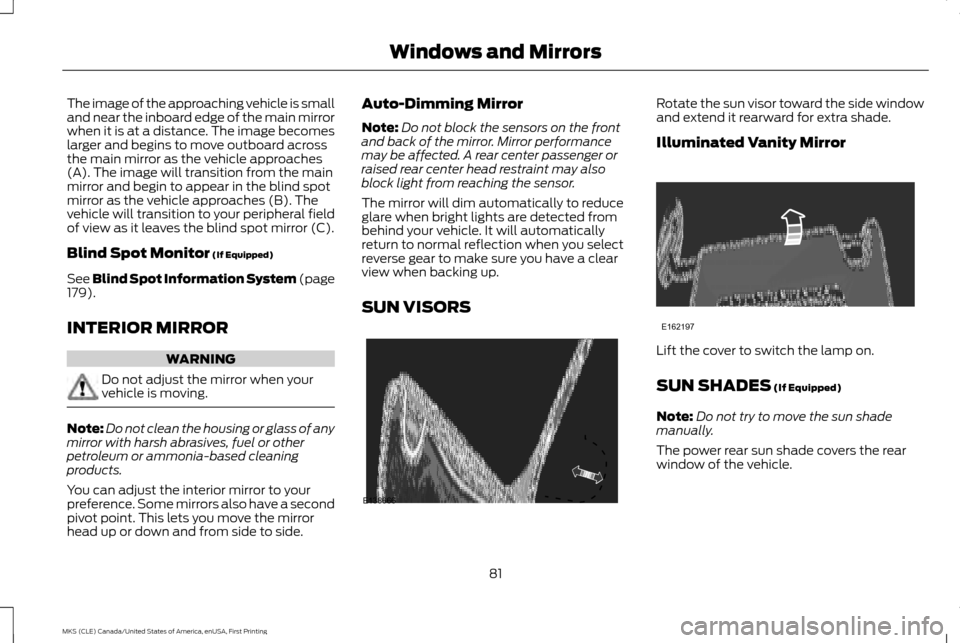
The image of the approaching vehicle is small
and near the inboard edge of the main mirror
when it is at a distance. The image becomes
larger and begins to move outboard across
the main mirror as the vehicle approaches
(A). The image will transition from the main
mirror and begin to appear in the blind spot
mirror as the vehicle approaches (B). The
vehicle will transition to your peripheral field
of view as it leaves the blind spot mirror (C).
Blind Spot Monitor (If Equipped)
See Blind Spot Information System (page
179
).
INTERIOR MIRROR WARNING
Do not adjust the mirror when your
vehicle is moving.
Note:
Do not clean the housing or glass of any
mirror with harsh abrasives, fuel or other
petroleum or ammonia-based cleaning
products.
You can adjust the interior mirror to your
preference. Some mirrors also have a second
pivot point. This lets you move the mirror
head up or down and from side to side. Auto-Dimming Mirror
Note:
Do not block the sensors on the front
and back of the mirror. Mirror performance
may be affected. A rear center passenger or
raised rear center head restraint may also
block light from reaching the sensor.
The mirror will dim automatically to reduce
glare when bright lights are detected from
behind your vehicle. It will automatically
return to normal reflection when you select
reverse gear to make sure you have a clear
view when backing up.
SUN VISORS Rotate the sun visor toward the side window
and extend it rearward for extra shade.
Illuminated Vanity Mirror
Lift the cover to switch the lamp on.
SUN SHADES
(If Equipped)
Note: Do not try to move the sun shade
manually.
The power rear sun shade covers the rear
window of the vehicle.
81
MKS (CLE) Canada/United States of America, enUSA, First Printing Windows and MirrorsE138666 E162197
Page 98 of 382
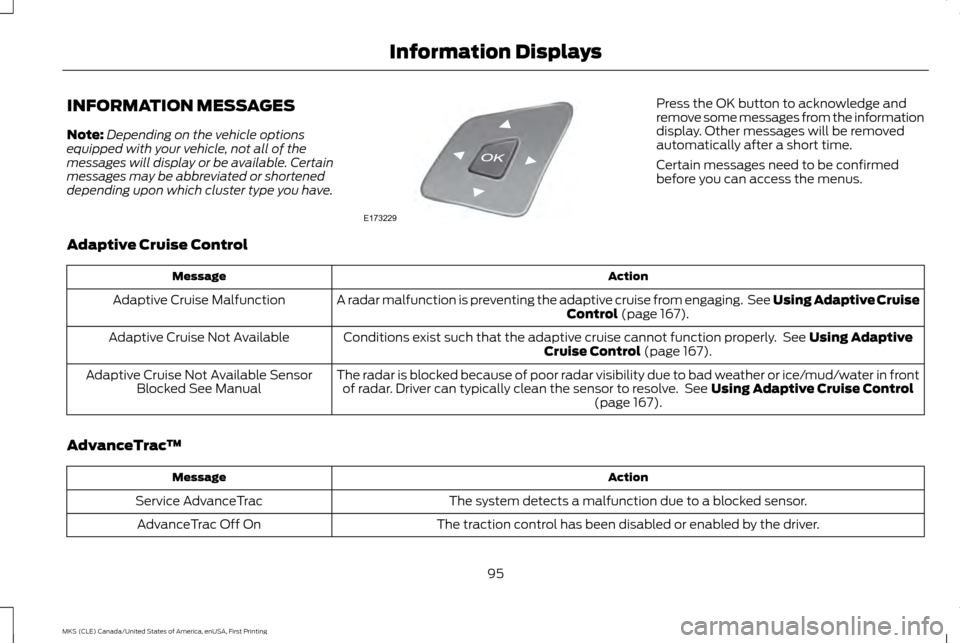
INFORMATION MESSAGES
Note:
Depending on the vehicle options
equipped with your vehicle, not all of the
messages will display or be available. Certain
messages may be abbreviated or shortened
depending upon which cluster type you have. Press the OK button to acknowledge and
remove some messages from the information
display. Other messages will be removed
automatically after a short time.
Certain messages need to be confirmed
before you can access the menus.
Adaptive Cruise Control Action
Message
A radar malfunction is preventing the adaptive cruise from engaging. See Using Adaptive Cruise Control (page 167).
Adaptive Cruise Malfunction
Conditions exist such that the adaptive cruise cannot function properly. See
Using Adaptive
Cruise Control (page 167).
Adaptive Cruise Not Available
The radar is blocked because of poor radar visibility due to bad weather or ice/mud/water in frontof radar. Driver can typically clean the sensor to resolve. See
Using Adaptive Cruise Control
(page 167).
Adaptive Cruise Not Available Sensor
Blocked See Manual
AdvanceTrac ™ Action
Message
The system detects a malfunction due to a blocked sensor.
Service AdvanceTrac
The traction control has been disabled or enabled by the driver.
AdvanceTrac Off On
95
MKS (CLE) Canada/United States of America, enUSA, First Printing Information DisplaysE173229
Page 100 of 382
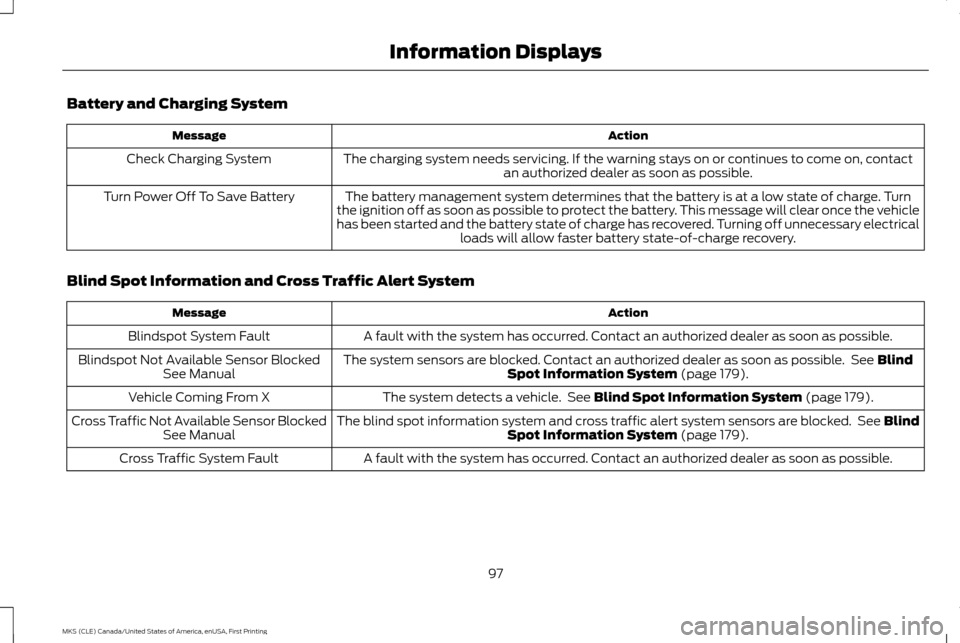
Battery and Charging System
Action
Message
The charging system needs servicing. If the warning stays on or continues to come on, contactan authorized dealer as soon as possible.
Check Charging System
The battery management system determines that the battery is at a low state of charge. Turn
the ignition off as soon as possible to protect the battery. This message will clear once the vehicle
has been started and the battery state of charge has recovered. Turning off unnecessary electrical loads will allow faster battery state-of-charge recovery.
Turn Power Off To Save Battery
Blind Spot Information and Cross Traffic Alert System Action
Message
A fault with the system has occurred. Contact an authorized dealer as soon as possible.
Blindspot System Fault
The system sensors are blocked. Contact an authorized dealer as soon as possible. See Blind
Spot Information System (page 179).
Blindspot Not Available Sensor Blocked
See Manual
The system detects a vehicle. See
Blind Spot Information System (page 179).
Vehicle Coming From X
The blind spot information system and cross traffic alert system sensors are blocked. See BlindSpot Information System
(page 179).
Cross Traffic Not Available Sensor Blocked
See Manual
A fault with the system has occurred. Contact an authorized dealer as soon as possible.
Cross Traffic System Fault
97
MKS (CLE) Canada/United States of America, enUSA, First Printing Information Displays
Page 101 of 382
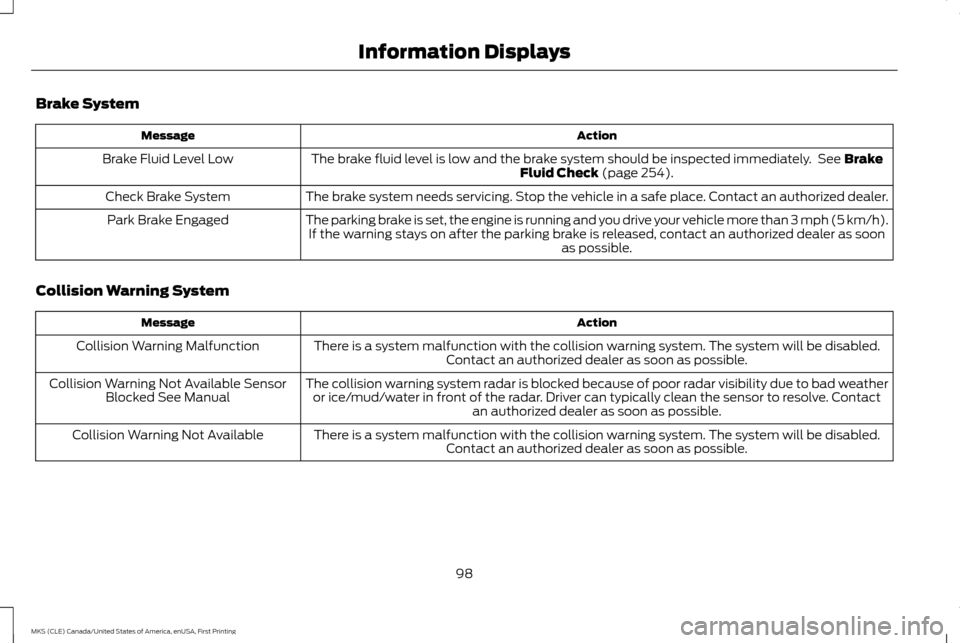
Brake System
Action
Message
The brake fluid level is low and the brake system should be inspected immediately. See Brake
Fluid Check (page 254).
Brake Fluid Level Low
The brake system needs servicing. Stop the vehicle in a safe place. Contact an authorized dealer.
Check Brake System
The parking brake is set, the engine is running and you drive your vehicle more than 3 mph (5 km/h).If the warning stays on after the parking brake is released, contact an authorized dealer as soon as possible.
Park Brake Engaged
Collision Warning System Action
Message
There is a system malfunction with the collision warning system. The system will be disabled.Contact an authorized dealer as soon as possible.
Collision Warning Malfunction
The collision warning system radar is blocked because of poor radar visibility due to bad weatheror ice/mud/water in front of the radar. Driver can typically clean the sensor to resolve. Contact an authorized dealer as soon as possible.
Collision Warning Not Available Sensor
Blocked See Manual
There is a system malfunction with the collision warning system. The system will be disabled.Contact an authorized dealer as soon as possible.
Collision Warning Not Available
98
MKS (CLE) Canada/United States of America, enUSA, First Printing Information Displays
Page 106 of 382
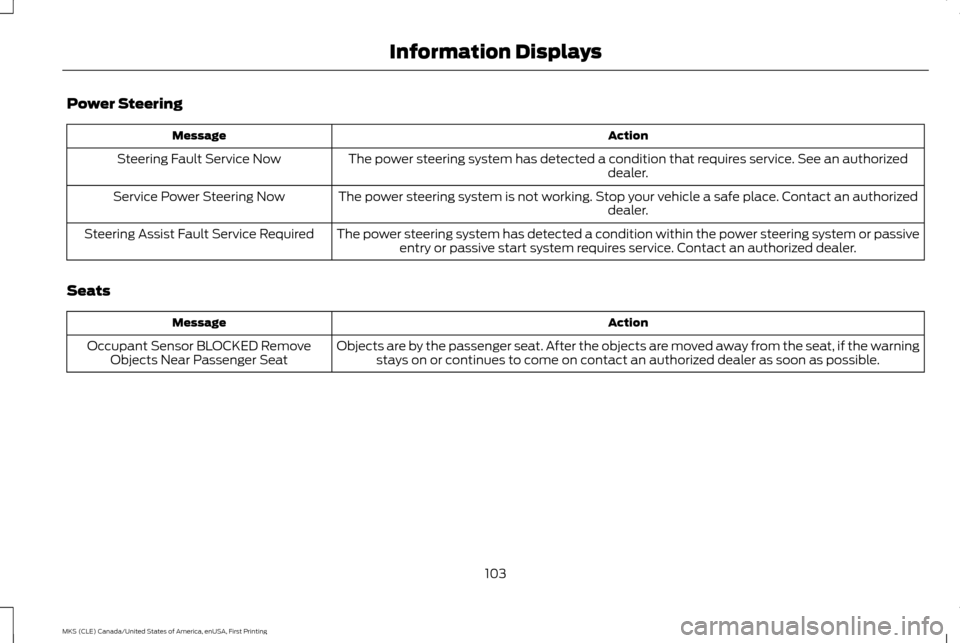
Power Steering
Action
Message
The power steering system has detected a condition that requires service. See an authorized dealer.
Steering Fault Service Now
The power steering system is not working. Stop your vehicle a safe place. Contact an authorized dealer.
Service Power Steering Now
The power steering system has detected a condition within the power steering system or passiveentry or passive start system requires service. Contact an authorized dealer.
Steering Assist Fault Service Required
Seats Action
Message
Objects are by the passenger seat. After the objects are moved away from the seat, if the warningstays on or continues to come on contact an authorized dealer as soon as possible.
Occupant Sensor BLOCKED Remove
Objects Near Passenger Seat
103
MKS (CLE) Canada/United States of America, enUSA, First Printing Information Displays
Page 107 of 382
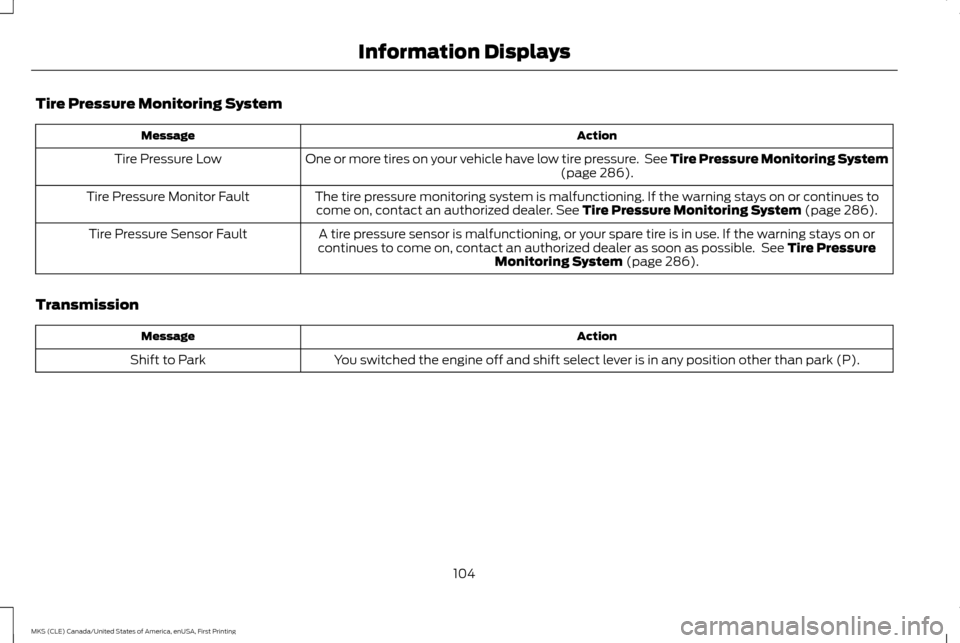
Tire Pressure Monitoring System
Action
Message
One or more tires on your vehicle have low tire pressure. See Tire Pressure Monitoring System (page 286).
Tire Pressure Low
The tire pressure monitoring system is malfunctioning. If the warning stays on or continues tocome on, contact an authorized dealer.
See Tire Pressure Monitoring System (page 286).
Tire Pressure Monitor Fault
A tire pressure sensor is malfunctioning, or your spare tire is in use. If the warning stays on or
continues to come on, contact an authorized dealer as soon as possible. See
Tire Pressure
Monitoring System (page 286).
Tire Pressure Sensor Fault
Transmission Action
Message
You switched the engine off and shift select lever is in any position other than park (P).
Shift to Park
104
MKS (CLE) Canada/United States of America, enUSA, First Printing Information Displays